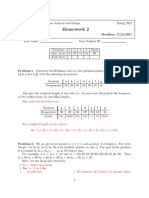0% found this document useful (0 votes)
105 views4 pagesPrelim1 Solution
The document contains solutions to a prelim exam for CS 4820, covering topics such as the stable matching problem, minimum cost spanning trees, dynamic programming for shift scheduling, and optimal life guard hiring algorithms. Each question includes a true/false statement with explanations or counter-examples, as well as algorithmic solutions with running time analyses. Common mistakes made by students are also highlighted to aid understanding.
Uploaded by
star masterCopyright
© © All Rights Reserved
We take content rights seriously. If you suspect this is your content, claim it here.
Available Formats
Download as PDF, TXT or read online on Scribd
0% found this document useful (0 votes)
105 views4 pagesPrelim1 Solution
The document contains solutions to a prelim exam for CS 4820, covering topics such as the stable matching problem, minimum cost spanning trees, dynamic programming for shift scheduling, and optimal life guard hiring algorithms. Each question includes a true/false statement with explanations or counter-examples, as well as algorithmic solutions with running time analyses. Common mistakes made by students are also highlighted to aid understanding.
Uploaded by
star masterCopyright
© © All Rights Reserved
We take content rights seriously. If you suspect this is your content, claim it here.
Available Formats
Download as PDF, TXT or read online on Scribd
/ 4




















































































